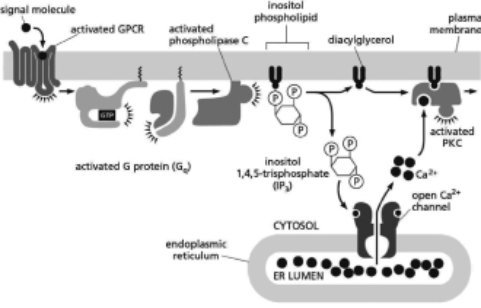Multiple Choice
Activated protein kinase C (PKC) can lead to the modification of the membrane lipids in the vicinity of the active PKC.Figure 16-17 shows how G proteins can indirectly activate PKC.You have discovered the enzyme activated by PKC that mediates the lipid modification.You call the enzyme Rafty and demonstrate that activated PKC directly phosphorylates Rafty, activating it to modify the plasma membrane lipids in the vicinity of the cell where PKC is active; these lipid modifications can be detected by dyes that bind to the modified lipids.Cells lacking Rafty do not have these modifications, even when PKC is active.Which of the following conditions would lead to signal-independent modification of the membrane lipids by Rafty?  Figure 16-17
Figure 16-17
A) the expression of a constitutively active phospholipase C
B) a mutation in the GPCR that binds the signal more tightly
C) a Ca2+ channel in the endoplasmic reticulum with an increased affinity for IP3
D) a mutation in the gene that encodes Rafty such that the enzyme can no longer be phosphorylated by PKC
Correct Answer:

Verified
Correct Answer:
Verified
Q12: When a signal needs to be sent
Q13: Bacteria undergo chemotaxis toward amino acids,
Q14: When adrenaline binds to adrenergic receptors on
Q15: A calmodulin-regulated kinase (CaM-kinase) is involved in
Q16: You are interested in cell-size regulation and
Q18: Receipt of extracellular signals can change cell
Q19: The growth factor RGF stimulates proliferation of
Q20: Acetylcholine binds to a GPCR on heart
Q21: Nuclear receptors have binding sites for a
Q22: You are interested in how cyclic-AMP-dependent protein